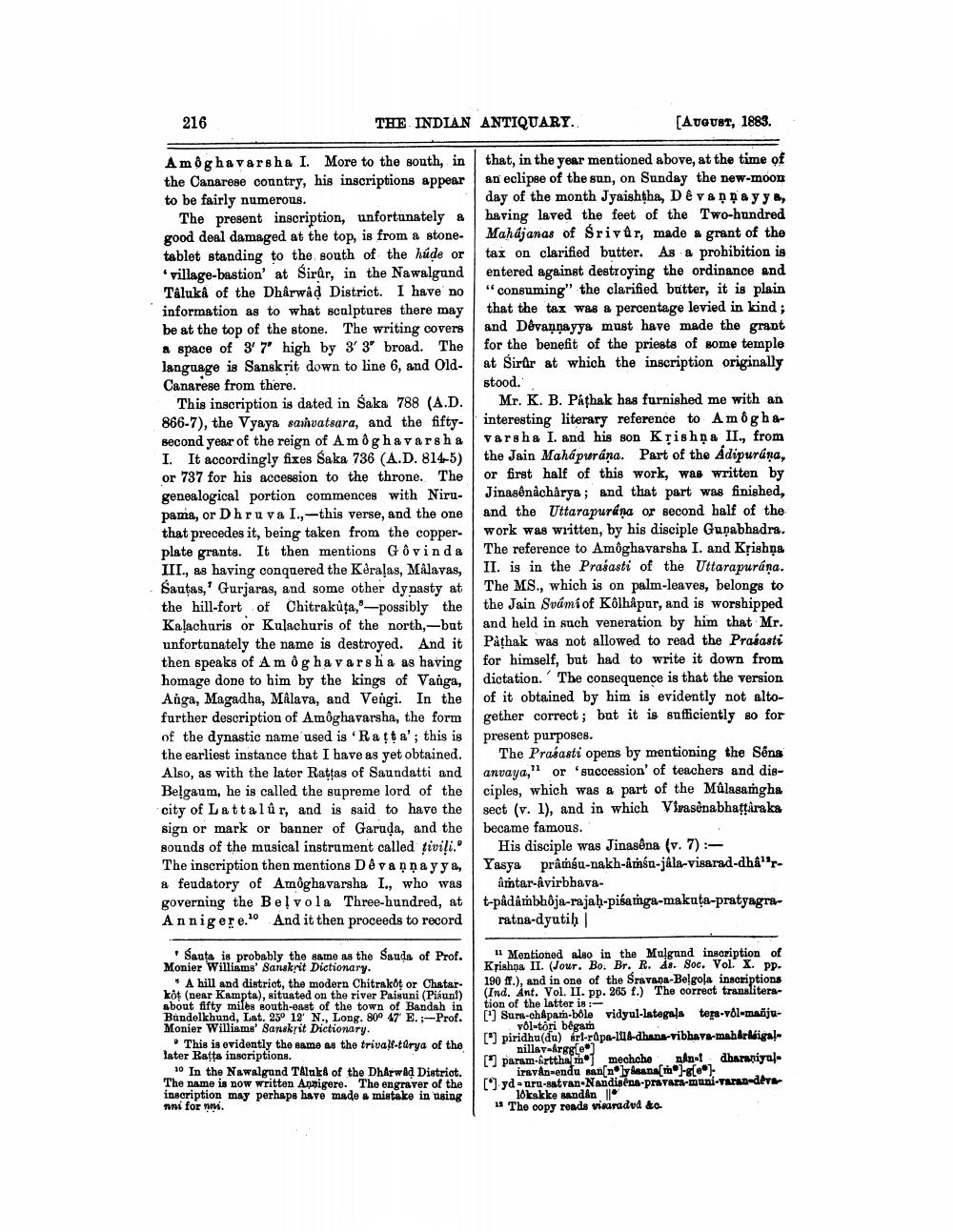________________
216
THE INDIAN ANTIQUARY.
[AUGUST, 1889.
Amôghavarsha I. More to the south, in the Canarese country, his inscriptions appear to be fairly numerous.
The present inscription, unfortunately a good deal damaged at the top, is from a stonetablet standing to the south of the hude or village-bastion at Sirûr, in the Nawalgund Taluka of the Dharwad District. I have no information as to what sculptures there may be at the top of the stone. The writing covers a space of 3' 7" high by 3' 3" broad. The language is Sanskrit down to line 6, and OldCanarese from there.
This inscription is dated in Saka 788 (A.D. 866-7), the Vyaya saavatsara, and the fiftysecond year of the reign of Amôghavarsha I. It accordingly fixes Saka 736 (A.D. 814-5) or 737 for his accession to the throne. The genealogical portion commences with Nirupama, or Dhruva I.,-this verse, and the one that precedes it, being taken from the copperplate grants. It then mentions Gôvinda III., as having conquered the Keralas, Målavas, Sautas,' Gurjaras, and some other dynasty at the hill-fort of Chitrakuta, * -possibly the Kalachuris or Kulachuris of the north, but unfortunately the name is destroyed. And it then speaks of Am ôg ha varsha as having homage done to him by the kings of Vanga, Anga, Magadha, Mâlava, and Vengi. In the further description of Amôghavarsha, the form of the dynastic name used is 'Ratta'; this is the earliest instance that I have as yet obtained. Also, as with the later Rattas of Saundatti and Belgaum, he is called the supreme lord of the city of Lattalûr, and is said to have the sign or mark or banner of Garuda, and the sounds of the musical instrument called fiviļi. The inscription then mentions Devanay ya, a feudatory of Amôghavarsha I., who was governing the Belvola Three-hundred, at Annig ere. And it then proceeds to record
that, in the year mentioned above, at the time of an eclipse of the sun, on Sunday the new-moon day of the month Jyaishtha, Dê vannayya, having laved the feet of the Two-hundred Mahdjanas of Srivůr, made a grant of the tax on clarified butter. As a prohibition is entered against destroying the ordinance and
consuming" the clarified butter, it is plain that the tax was a percentage levied in kind; and Dévannayya must have made the grant for the benefit of the priests of some temple at Sirar at which the inscription originally stood.
Mr. K. B. Pathak has furnished me with an interesting literary reference to Amôg h&varsha I. and his son Krishna II., from the Jain Mahápurána. Part of the Adipurána, or first half of this work, was written by Jinasônacharya; and that part was finished, and the Uttarapurána or second half of the work was written, by his disciple Gupabhadra. The reference to Amôghavarsha I. and Krishņa II. is in the Prasasti of the Uttarapurána. The MS., which is on palm-leaves, belongs to the Jain Svámi of Kölhåpur, and is worshipped and held in such veneration by him that Mr. Pathak was not allowed to read the Prasasti for himself, but had to write it down from dictation. The consequence is that the version of it obtained by him is evidently not altogether correct; but it is sufficiently so for present purposes.
The Prasasti opens by mentioning the Sena anvaya," or "succession of teachers and disciples, which was a part of the Múlasamgha sect (v. 1), and in which Virasénabhattaraka became famous
His disciple was Jinasêna (v.7):Yasya pragu-nakh-amśn-jala-visarad-dhar
amtar-åvirbhavat-pâdarbhoja-rajah-piśamga-makuta-pratyagra
ratna-dyutih
Santa is probably the same as the Sauds of Prof. Monier Williams' Sanskrit Dictionary.
• A hill and district, the modern Chitrakot or Chatar. kot (near Kampta), situated on the river Paisuni (Piauni) about fifty miles south-onet of the town of Bandah in Bundelkhund, Lat. 25° 12' N., Long. 80° 47' E. :--Prof. Monier Williams' Sanskrit Dictionary.
. This is evidently the same as the trivalf-tarya of the later Ratta inscriptions.
10 In the Nawalgund Tilaks of the Dharwad District. The name is now written Anzigere. The engraver of the inscription may perhaps have made a mistake in using ani fornmi.
u Mentioned also in the Molgund inscription of Kộishna II. (Jour. Bo. Br. R. ds. Soc. Vol. x. PP190 ff.), and in one of the Sravana-Belgola inscriptions (Ind. Ant. Vol. II. pp. 265 f.) The correct transliteration of the latter is :("] Sura-ch&pam-bóle vidyul-lategala tera-vol-mažju
vol-tóri bēgam [ piridhu(du) bri-rupa-2016-dhana-vibhava-maheradiga!
nillav-Args[eo] " param-arttha mo mechcho ninat dharaniyal
iravan-endu san[n@lyana(m -[e? [*] yduru-satvan-Nandiséns-prayara-muni-Taradero
10kskke sandán 1 1 The copy reada visaradus &c




